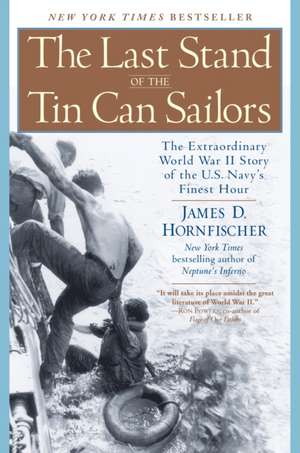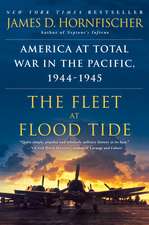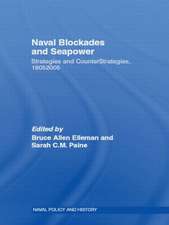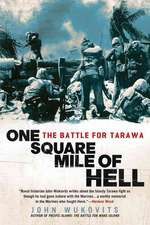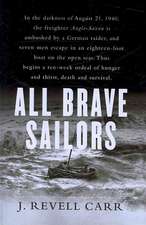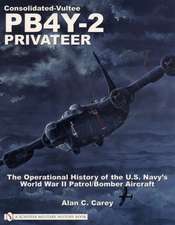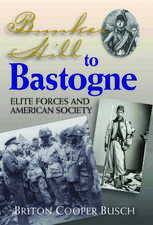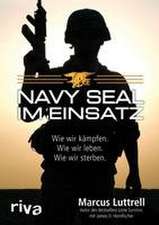The Last Stand of the Tin Can Sailors: The Extraordinary World War II Story of the U.S. Navy's Finest Hour
Autor James D. Hornfischeren Limba Engleză Paperback – 28 feb 2005
With these words, Lieutenant Commander Robert W. Copeland addressed the crew of the destroyer escort USS Samuel B. Roberts on the morning of October 25, 1944, off the Philippine Island of Samar. On the horizon loomed the mightiest ships of the Japanese navy, a massive fleet that represented the last hope of a staggering empire. All that stood between it and Douglas MacArthur’s vulnerable invasion force were the Roberts and the other small ships of a tiny American flotilla poised to charge into history.
In the tradition of the #1 New York Times bestseller Flags of Our Fathers, James D. Hornfischer paints an unprecedented portrait of the Battle of Samar, a naval engagement unlike any other in U.S. history—and captures with unforgettable intensity the men, the strategies, and the sacrifices that turned certain defeat into a legendary victory.
From the Hardcover edition.
Preț: 117.60 lei
Preț vechi: 157.06 lei
-25% Nou
Puncte Express: 176
Preț estimativ în valută:
22.50€ • 23.55$ • 18.73£
22.50€ • 23.55$ • 18.73£
Carte disponibilă
Livrare economică 10-17 martie
Livrare express 21-27 februarie pentru 82.30 lei
Preluare comenzi: 021 569.72.76
Specificații
ISBN-13: 9780553381481
ISBN-10: 0553381482
Pagini: 528
Ilustrații: 2 INSERTS + LINE DRWS. +MAPS
Dimensiuni: 158 x 235 x 25 mm
Greutate: 0.75 kg
Ediția:Revised
Editura: Bantam
ISBN-10: 0553381482
Pagini: 528
Ilustrații: 2 INSERTS + LINE DRWS. +MAPS
Dimensiuni: 158 x 235 x 25 mm
Greutate: 0.75 kg
Ediția:Revised
Editura: Bantam
Notă biografică
James D. Hornfischer is a writer, literary agent, and former book editor. The Last Stand of the Tin Can Sailors, his first book, won the 2004 Samuel Eliot Morison Award for Naval Literature. He lives in Austin, Texas, with his wife and their three children.
From the Hardcover edition.
From the Hardcover edition.
Extras
October 25, 1944
San Bernardino Strait, the Philippines
A giant stalked through the darkness. In the moonless calm after midnight, the great fleet seemed not so much to navigate the narrow strait as to fill it with armor and steel. Barely visible even to a night-trained eye, the long silhouettes of twenty-three warships passed in a column ten miles long, guided by the dim glow of the channel lights in the passage threading between the headlands of Luzon and Samar.
That such a majestic procession should move without challenge was surprising, inexplicable even, in light of the vicious reception the Americans had already given it on its journey from Borneo to this critical point. Having weathered submarine ambush the night before, and assault by wave after wave of angry blue aircraft the previous afternoon, Vice Adm. Takeo Kurita, steward of the last hopes of the Japanese empire, would have been right to expect the worst. But then Kurita knew that heavenly influences could be counted upon to trump human planning. In war, events seldom cooperate with expectation. Given the dependable cruelty of the divine hand, most unexpected of all, perhaps was this fact: Unfolding at last after more than two years of retreat, Japan's ornate plan to defend the Philippines appeared to be working perfectly.
For its complexity, for its scale, for its extravagantly optimistic overelegance, the Sho plan represented the very best and also the very worst tendencies of the Imperial Navy. The Japanese military's fondness for bold strokes had been evident from the earliest days of the war: the sudden strike on Pearl Harbor, the sprawling offensive into the Malay Peninsula, the lightning thrust into the Philippines, and the smaller but no less swift raids on Wake Island, Guam, Hong Kong and northern Borneo. Allied commanders believed the Japanese could not tackle more than one objective at a time. The sudden spasm of advances of December 1941, in which Japan struck with overwhelming force in eight directions at once, refuted that fallacy.
In the war's early days, Japan had overwhelmed enemies stretched thin by the need to defend their scattered colonies throughout the hemisphere. But as the war continued, the geographical breadth of its conquests saddled Japan in turn with the necessity of piecemeal defense. America rallied, the home front's spirits boosted by the gallant if doomed defense of Wake Island and by Jimmy Doolittle's raid on Tokyo. As heavier blows landed--the Battle of the Coral Sea, the triumph at Midway, the landings on Guadalcanal and the leapfrogging campaign through the Solomons and up the northern coast of New Guinea--Japan's overstretched domain was in turn overrun by the resurgent Americans. The hard charge of U.S. Marines up the bloody path of Tarawa, the Marshalls, and the Marianas Islands had put American forces, by the middle of 1944, in position to sever the vital artery connecting the Japanese home islands to their resource-rich domain in East Asia. The Philippines were that pressure point. Their seizure by the Americans would push the entire Japanese empire toward collapse.
The strength America wielded in its counteroffensive was the nightmare prophecy foretold by Admiral Isoraku Yamamoto and other far-sighted Japanese commanders who had long dreaded war with an industrial giant. As two great American fleets closed in on the Philippines in October, with Gen. Douglas MacArthur's troops spearheading the ground assault on the Philippine island of Leyte, Japan activated its own last-ditch plan to forestall the inevitable defeat. It was unfolding now. Admiral Kurita was its linchpin.
The Sho plan's audacity--orchestrating the movements of four fleets spread across thousands of miles of ocean and the land-based aircraft necessary to protect them--was both its genius and its potentially disastrous weakness. Admiral Jisaburo Ozawa, leading the remnants of Japan's once glorious naval air arm, would steam south from Japan with his aircraft carriers and try to lure the American fast carrier groups north, away from Leyte. With the U.S. flattops busy pursuing the decoy, two Japanese battleship groups would close on Leyte from the north and south and deal MacArthur a surprise, killing blow.
Admiral Kurita had departed Brunei on October 22 with his powerful Center Force, led by the Yamato and Musashi, the two largest warships afloat, aiming to slip across the South China Sea, pass through San Bernardino Strait above Samar Island, and close on the Leyte beachhead from the north. Meanwhile, the Southern Force, led by Vice Adm. Shoji Nishimura and supported by Vice Adm. Kiyohide Shima, would cross the Sulu Sea and approach Leyte from the south, through Surigao Strait.
In the morning, after their thousand-mile journeys through perilous waters, Kurita's and Nishimura's battleship groups would rendezvous at 9:00 a.m. off Leyte island's eastern shore, encircling the islands like hands around a throat. Then they would turn their massive guns on MacArthur's invasion force. Japan would at last win the decisive battle that had eluded it in the twenty-eight months since the debacle at Midway.
Kurita's grandfather had been a great scholar of early Meiji literature. His father too had been a distinguished man of learning, author of a magisterial history of his native land. Now Takeo Kurita, who preferred action to words, would make his own contribution to it.
Off Samar
Gathered around the radio set in the combat information center of the destroyer escort USS Samuel B. Roberts, they listened as a hundred miles to their south, their heavier counterparts in the Seventh Fleet encountered the first signs that the Japanese defense of the Philippines was underway. There was no telling precisely what their countrymen faced. It was something big--that much was for sure. And yet, until the scale of the far-off battle became too apparent to ignore, they would pretend it was just another midwatch. By the routine indications, it was. They watched the radar scopes and the scopes watched back, bathing the darkened compartment in cathode-green fluorescence but revealing no enemy nearby. The southwest Pacific slept. But something was on the radio, and it put the lie to the silent night.
The tactical circuit they were using to eavesdrop was meant for sending and receiving short-range messages from ship to ship. Officers used it to trade scuttlebutt with other vessels about what their radar was showing, about their course changes, about the targets they were tracking. By day, the high-frequency Talk Between Ships signal reached only to the line of sight. But tonight, the earth's atmosphere was working its magic and the TBS broadcasts from faraway ships were propagating wildly, bouncing over the horizon to the small warship's vigilant antennae.
They had come from small places to accomplish big things. As the American liberation of the Philippines unfolded, the greenhorn enlistees who made up majority of the Samuel B. Roberts's 224-man complement could scarcely have guessed at the scope of the drama to come. On the midnight-to-four-a.m. midwatch, the Roberts's skipper, Lt. Cdr. Robert W. Copeland, his executive officer, Lt. Everett E. "Bob" Roberts, his communications officer, Lt. Tom Stevenson, and the young men under them in the little ship's combat information center (CIC) had little else to do than while away the night as the destroyer escort zigzagged lazily off the eastern coast of Samar with the twelve other ships of its task unit. When morning warmed the eastern horizon, the daily routine would begin anew: run through morning general quarters, then edge closer to shore with the six small aircraft carriers that were the purpose of the flotilla's existence and launch air strikes in support of the American troops advancing into Leyte Island.
With a mixture of pride and resignation, the men of the Seventh Fleet called themselves "MacArthur's Navy." The unusual arrangement that placed the powerful armada under Army command was the product of the long-standing interservice rivalry. The two service branches, each wildly successful, were beating divergent paths to Tokyo. From June 1943 to August 1944, MacArthur's forces had leapfrogged across the southern Pacific, staging eighty-seven successful amphibious landings in a drive from Dutch New Guinea and west-by-northwestward across a thousand-mile swath of islanded sea to the foot of the Philippine archipelago. Simultaneously, Fleet Adm. Chester W. Nimitz's fast carrier groups, accompanied by battle-hardened Marine divisions, had driven across the Central Pacific.
The perpetual motion of the American industrial machine had built a naval and amphibious arsenal of such staggering size, range and striking power that the vast sea seemed to shrink around it. "Our naval power in the western Pacific was such that we could have challenged the combined fleets of the world," Adm. William F. Halsey, Jr., would write in his memoirs. The rival commanders had used it so well that the Pacific Ocean was no longer large enough to hold their conflicting ambitions. There was little of the Pacific left to liberate. Behind them lay conquered ground. Ahead, looking westward to the Philippines and beyond, was a short watery vista bounded by the shores of Manchuria, China, and Indonesia. Once the Far East had seemed a world away. Allied soldiers, marines, sailors, and airmen operating along the far Pacific rim early in the war--the Flying Tigers in China, the U.S. Asiatic Fleet in Java, the marines on Wake Island, the defenders of Bataan and Corregidor--were consigned to oblivion, so desperately far from home. Now that U.S. forces had crossed that world, the greatest challenge was to agree on how to deliver the inevitable victory as quickly as possible.
For most of the summer of 1944 a debate raged between Army and Navy planners about where to attack next. On July 21 Franklin Delano Roosevelt, newly nominated at the Chicago Democratic Convention for a fourth presidential term, boarded the heavy cruiser Baltimore at San Diego and sailed to Oahu for a summit meeting of his Army and Navy leaders. In a sober discussion after dinner at the presidential residence in Honolulu, Nimitz and MacArthur repeated to their commander in chief the same arguments they had been espousing to the Joint Chiefs of Staff these many weeks. The Navy preferred an assault on Formosa (now Taiwan). MacArthur had other priorities. On a large map FDR pointed to Mindanao Island, southernmost in the Philippines archipelago, and asked, "Douglas, where do we go from here?"
Without hesitation, MacArthur replied, "Leyte, Mr. President, and then Luzon!"
It had been nearly three years since Bataan fell and the American Caesar fled that haunted peninsula by night aboard a PT boat, arrived in Mindanao, and boarded a B-17 bomber for Australia to endure the exile of the defeated. On March 20, 1942, at a press conference at the Adelaide train station, he declared, "The President of the United States ordered me to break through the Japanese lines . . . for the purpose, as I understand it, of organizing the American offensive against Japan, a primary object of which is the relief of the Philippines. I came through and I shall return." Torn from context and conflated to a national commitment, "I shall return" became MacArthur's calling card and his albatross.
For the general, fulfilling his famous promise to the Philippine people was not solely a question of military strategy but also a point of personal and national honor. He told his president of the backlash in public opinion that might arise if the United States abandoned seventeen million loyal Filipinos to their Japanese conquerors. And the lives of some 3,700 American prisoners--the ravaged survivors of Bataan and Corregidor--would fall in immediate peril if the archipelago were bypassed and its occupying garrison starved out, a strategy many U.S. planners favored after seeing it succeed against other Japanese strongholds.
Nimitz reiterated the Navy's preference for driving further westward to seize Formosa. Such a move would land a more decisive blow against the long communications and supply lines that linked Tokyo to its bases and fuel supplies in Sumatra and Borneo. MacArthur and Nimitz made their best arguments, and after extended discussion FDR sided with his general. MacArthur had flown in with virtually no time to prepare. Such was the force of his personality and persuasive gifts that even Admiral Nimitz was ultimately won over. The Philippines--Leyte--would be next.
And so it began. Two great fleets gathered at staging areas at Manus in the Admiralty Islands and at Ulithi in the Carolines for the final assault on the Philippines. Under MacArthur, as it had been since March 1943, was Vice Adm. Thomas C. Kinkaid's Seventh Fleet. Nimitz retained the Third Fleet, which sailed under the flag of Admiral Halsey.
The Seventh Fleet had a wide variety of ships to ferry and supply the invasion force itself. In addition to an alphabet soup of troop-, tank-, and equipment-carrying landing craft--APAs, LSTs, LSDs, LSMs, LCTs, LCIs and LVTs--it had amphibious command ships, ammunition ships, cargo ships, oilers, seaplane tenders, motor torpedo boats, patrol craft, coast guard frigates, minesweepers, minelayers, repair and salvage ships, water tankers, floating drydocks, and hospital ships. Standing guard over this wide assortment of hulls were the combatant vessels of the Seventh Fleet: Jesse Oldendorf's bombardment group, composed of battleships and cruisers, and, farther offshore, Task Group 77.4, a force of sixteen escort carriers under Rear Adm. Thomas L. Sprague, divided into three task units and screened by destroyers and destroyer escorts.
On October 20, 1944, two and a half years after retreating from the strategic archipelago, Douglas MacArthur, Supreme Commander, Allied Forces, Southwest Pacific Area, made good on his grand promise. At seven a.m. sharp, the Seventh Fleet battleships Maryland, West Virginia and Mississippi trained their main batteries on Leyte Island's inland hills and opened fire on the conquerors and murderers of Bataan. The American liberation of the Philippines was underway. For exactly two hours the massive rifles roared. Then, precisely on schedule, the shelling stopped and Higgins boats began spilling out of the larger ships that housed them. Lt. Gen. Walter Krueger's troops clambered down rope ladders thrown over the sides, the landing craft circling until their full number had gathered. Then the invasion force spiraled out into a series of waves that surged across San Pedro Bay and broke on Leyte's eastern shore.
As two corps of Sixth Army soldiers pushed inland from the coastal towns of Dulag and Tacloban, newspapers back home captivated the public with reports of the ongoing offensive. macarthur returns to philippines in personal command of americans. fdr voices gratitude for nation. The drama had been stage-managed from the beginning. On Leyte's Red Beach the cameras were ready for the general's star turn, carefully positioned to capture the liberator coming ashore. He obliged them with a flourish, wading from a landing craft ramp to inspect the damage inflicted by the Navy's bombardment. Then, with Philippine president Sergio Osme-a at his side, General MacArthur, resplendent in pressed khakis, sunglasses, and marshal's cap, corncob pipe in hand, leaned into a microphone held by an Army Signal Corps volunteer and spoke to history:
This is the voice of freedom, General MacArthur speaking. People of the Philippines! I have returned. By the grace of Almighty God, our forces stand again on Philippine soil--soil consecrated in the blood of our two peoples. . . . Rally to me. Let the indomitable spirit of Bataan and Corregidor lead on. As the lines of battle roll forward to bring you within the zone of operations, rise and strike. . . . The guidance of divine God points the way. Follow in His Name to the Holy Grail of righteous victory!
From the Hardcover edition.
San Bernardino Strait, the Philippines
A giant stalked through the darkness. In the moonless calm after midnight, the great fleet seemed not so much to navigate the narrow strait as to fill it with armor and steel. Barely visible even to a night-trained eye, the long silhouettes of twenty-three warships passed in a column ten miles long, guided by the dim glow of the channel lights in the passage threading between the headlands of Luzon and Samar.
That such a majestic procession should move without challenge was surprising, inexplicable even, in light of the vicious reception the Americans had already given it on its journey from Borneo to this critical point. Having weathered submarine ambush the night before, and assault by wave after wave of angry blue aircraft the previous afternoon, Vice Adm. Takeo Kurita, steward of the last hopes of the Japanese empire, would have been right to expect the worst. But then Kurita knew that heavenly influences could be counted upon to trump human planning. In war, events seldom cooperate with expectation. Given the dependable cruelty of the divine hand, most unexpected of all, perhaps was this fact: Unfolding at last after more than two years of retreat, Japan's ornate plan to defend the Philippines appeared to be working perfectly.
For its complexity, for its scale, for its extravagantly optimistic overelegance, the Sho plan represented the very best and also the very worst tendencies of the Imperial Navy. The Japanese military's fondness for bold strokes had been evident from the earliest days of the war: the sudden strike on Pearl Harbor, the sprawling offensive into the Malay Peninsula, the lightning thrust into the Philippines, and the smaller but no less swift raids on Wake Island, Guam, Hong Kong and northern Borneo. Allied commanders believed the Japanese could not tackle more than one objective at a time. The sudden spasm of advances of December 1941, in which Japan struck with overwhelming force in eight directions at once, refuted that fallacy.
In the war's early days, Japan had overwhelmed enemies stretched thin by the need to defend their scattered colonies throughout the hemisphere. But as the war continued, the geographical breadth of its conquests saddled Japan in turn with the necessity of piecemeal defense. America rallied, the home front's spirits boosted by the gallant if doomed defense of Wake Island and by Jimmy Doolittle's raid on Tokyo. As heavier blows landed--the Battle of the Coral Sea, the triumph at Midway, the landings on Guadalcanal and the leapfrogging campaign through the Solomons and up the northern coast of New Guinea--Japan's overstretched domain was in turn overrun by the resurgent Americans. The hard charge of U.S. Marines up the bloody path of Tarawa, the Marshalls, and the Marianas Islands had put American forces, by the middle of 1944, in position to sever the vital artery connecting the Japanese home islands to their resource-rich domain in East Asia. The Philippines were that pressure point. Their seizure by the Americans would push the entire Japanese empire toward collapse.
The strength America wielded in its counteroffensive was the nightmare prophecy foretold by Admiral Isoraku Yamamoto and other far-sighted Japanese commanders who had long dreaded war with an industrial giant. As two great American fleets closed in on the Philippines in October, with Gen. Douglas MacArthur's troops spearheading the ground assault on the Philippine island of Leyte, Japan activated its own last-ditch plan to forestall the inevitable defeat. It was unfolding now. Admiral Kurita was its linchpin.
The Sho plan's audacity--orchestrating the movements of four fleets spread across thousands of miles of ocean and the land-based aircraft necessary to protect them--was both its genius and its potentially disastrous weakness. Admiral Jisaburo Ozawa, leading the remnants of Japan's once glorious naval air arm, would steam south from Japan with his aircraft carriers and try to lure the American fast carrier groups north, away from Leyte. With the U.S. flattops busy pursuing the decoy, two Japanese battleship groups would close on Leyte from the north and south and deal MacArthur a surprise, killing blow.
Admiral Kurita had departed Brunei on October 22 with his powerful Center Force, led by the Yamato and Musashi, the two largest warships afloat, aiming to slip across the South China Sea, pass through San Bernardino Strait above Samar Island, and close on the Leyte beachhead from the north. Meanwhile, the Southern Force, led by Vice Adm. Shoji Nishimura and supported by Vice Adm. Kiyohide Shima, would cross the Sulu Sea and approach Leyte from the south, through Surigao Strait.
In the morning, after their thousand-mile journeys through perilous waters, Kurita's and Nishimura's battleship groups would rendezvous at 9:00 a.m. off Leyte island's eastern shore, encircling the islands like hands around a throat. Then they would turn their massive guns on MacArthur's invasion force. Japan would at last win the decisive battle that had eluded it in the twenty-eight months since the debacle at Midway.
Kurita's grandfather had been a great scholar of early Meiji literature. His father too had been a distinguished man of learning, author of a magisterial history of his native land. Now Takeo Kurita, who preferred action to words, would make his own contribution to it.
Off Samar
Gathered around the radio set in the combat information center of the destroyer escort USS Samuel B. Roberts, they listened as a hundred miles to their south, their heavier counterparts in the Seventh Fleet encountered the first signs that the Japanese defense of the Philippines was underway. There was no telling precisely what their countrymen faced. It was something big--that much was for sure. And yet, until the scale of the far-off battle became too apparent to ignore, they would pretend it was just another midwatch. By the routine indications, it was. They watched the radar scopes and the scopes watched back, bathing the darkened compartment in cathode-green fluorescence but revealing no enemy nearby. The southwest Pacific slept. But something was on the radio, and it put the lie to the silent night.
The tactical circuit they were using to eavesdrop was meant for sending and receiving short-range messages from ship to ship. Officers used it to trade scuttlebutt with other vessels about what their radar was showing, about their course changes, about the targets they were tracking. By day, the high-frequency Talk Between Ships signal reached only to the line of sight. But tonight, the earth's atmosphere was working its magic and the TBS broadcasts from faraway ships were propagating wildly, bouncing over the horizon to the small warship's vigilant antennae.
They had come from small places to accomplish big things. As the American liberation of the Philippines unfolded, the greenhorn enlistees who made up majority of the Samuel B. Roberts's 224-man complement could scarcely have guessed at the scope of the drama to come. On the midnight-to-four-a.m. midwatch, the Roberts's skipper, Lt. Cdr. Robert W. Copeland, his executive officer, Lt. Everett E. "Bob" Roberts, his communications officer, Lt. Tom Stevenson, and the young men under them in the little ship's combat information center (CIC) had little else to do than while away the night as the destroyer escort zigzagged lazily off the eastern coast of Samar with the twelve other ships of its task unit. When morning warmed the eastern horizon, the daily routine would begin anew: run through morning general quarters, then edge closer to shore with the six small aircraft carriers that were the purpose of the flotilla's existence and launch air strikes in support of the American troops advancing into Leyte Island.
With a mixture of pride and resignation, the men of the Seventh Fleet called themselves "MacArthur's Navy." The unusual arrangement that placed the powerful armada under Army command was the product of the long-standing interservice rivalry. The two service branches, each wildly successful, were beating divergent paths to Tokyo. From June 1943 to August 1944, MacArthur's forces had leapfrogged across the southern Pacific, staging eighty-seven successful amphibious landings in a drive from Dutch New Guinea and west-by-northwestward across a thousand-mile swath of islanded sea to the foot of the Philippine archipelago. Simultaneously, Fleet Adm. Chester W. Nimitz's fast carrier groups, accompanied by battle-hardened Marine divisions, had driven across the Central Pacific.
The perpetual motion of the American industrial machine had built a naval and amphibious arsenal of such staggering size, range and striking power that the vast sea seemed to shrink around it. "Our naval power in the western Pacific was such that we could have challenged the combined fleets of the world," Adm. William F. Halsey, Jr., would write in his memoirs. The rival commanders had used it so well that the Pacific Ocean was no longer large enough to hold their conflicting ambitions. There was little of the Pacific left to liberate. Behind them lay conquered ground. Ahead, looking westward to the Philippines and beyond, was a short watery vista bounded by the shores of Manchuria, China, and Indonesia. Once the Far East had seemed a world away. Allied soldiers, marines, sailors, and airmen operating along the far Pacific rim early in the war--the Flying Tigers in China, the U.S. Asiatic Fleet in Java, the marines on Wake Island, the defenders of Bataan and Corregidor--were consigned to oblivion, so desperately far from home. Now that U.S. forces had crossed that world, the greatest challenge was to agree on how to deliver the inevitable victory as quickly as possible.
For most of the summer of 1944 a debate raged between Army and Navy planners about where to attack next. On July 21 Franklin Delano Roosevelt, newly nominated at the Chicago Democratic Convention for a fourth presidential term, boarded the heavy cruiser Baltimore at San Diego and sailed to Oahu for a summit meeting of his Army and Navy leaders. In a sober discussion after dinner at the presidential residence in Honolulu, Nimitz and MacArthur repeated to their commander in chief the same arguments they had been espousing to the Joint Chiefs of Staff these many weeks. The Navy preferred an assault on Formosa (now Taiwan). MacArthur had other priorities. On a large map FDR pointed to Mindanao Island, southernmost in the Philippines archipelago, and asked, "Douglas, where do we go from here?"
Without hesitation, MacArthur replied, "Leyte, Mr. President, and then Luzon!"
It had been nearly three years since Bataan fell and the American Caesar fled that haunted peninsula by night aboard a PT boat, arrived in Mindanao, and boarded a B-17 bomber for Australia to endure the exile of the defeated. On March 20, 1942, at a press conference at the Adelaide train station, he declared, "The President of the United States ordered me to break through the Japanese lines . . . for the purpose, as I understand it, of organizing the American offensive against Japan, a primary object of which is the relief of the Philippines. I came through and I shall return." Torn from context and conflated to a national commitment, "I shall return" became MacArthur's calling card and his albatross.
For the general, fulfilling his famous promise to the Philippine people was not solely a question of military strategy but also a point of personal and national honor. He told his president of the backlash in public opinion that might arise if the United States abandoned seventeen million loyal Filipinos to their Japanese conquerors. And the lives of some 3,700 American prisoners--the ravaged survivors of Bataan and Corregidor--would fall in immediate peril if the archipelago were bypassed and its occupying garrison starved out, a strategy many U.S. planners favored after seeing it succeed against other Japanese strongholds.
Nimitz reiterated the Navy's preference for driving further westward to seize Formosa. Such a move would land a more decisive blow against the long communications and supply lines that linked Tokyo to its bases and fuel supplies in Sumatra and Borneo. MacArthur and Nimitz made their best arguments, and after extended discussion FDR sided with his general. MacArthur had flown in with virtually no time to prepare. Such was the force of his personality and persuasive gifts that even Admiral Nimitz was ultimately won over. The Philippines--Leyte--would be next.
And so it began. Two great fleets gathered at staging areas at Manus in the Admiralty Islands and at Ulithi in the Carolines for the final assault on the Philippines. Under MacArthur, as it had been since March 1943, was Vice Adm. Thomas C. Kinkaid's Seventh Fleet. Nimitz retained the Third Fleet, which sailed under the flag of Admiral Halsey.
The Seventh Fleet had a wide variety of ships to ferry and supply the invasion force itself. In addition to an alphabet soup of troop-, tank-, and equipment-carrying landing craft--APAs, LSTs, LSDs, LSMs, LCTs, LCIs and LVTs--it had amphibious command ships, ammunition ships, cargo ships, oilers, seaplane tenders, motor torpedo boats, patrol craft, coast guard frigates, minesweepers, minelayers, repair and salvage ships, water tankers, floating drydocks, and hospital ships. Standing guard over this wide assortment of hulls were the combatant vessels of the Seventh Fleet: Jesse Oldendorf's bombardment group, composed of battleships and cruisers, and, farther offshore, Task Group 77.4, a force of sixteen escort carriers under Rear Adm. Thomas L. Sprague, divided into three task units and screened by destroyers and destroyer escorts.
On October 20, 1944, two and a half years after retreating from the strategic archipelago, Douglas MacArthur, Supreme Commander, Allied Forces, Southwest Pacific Area, made good on his grand promise. At seven a.m. sharp, the Seventh Fleet battleships Maryland, West Virginia and Mississippi trained their main batteries on Leyte Island's inland hills and opened fire on the conquerors and murderers of Bataan. The American liberation of the Philippines was underway. For exactly two hours the massive rifles roared. Then, precisely on schedule, the shelling stopped and Higgins boats began spilling out of the larger ships that housed them. Lt. Gen. Walter Krueger's troops clambered down rope ladders thrown over the sides, the landing craft circling until their full number had gathered. Then the invasion force spiraled out into a series of waves that surged across San Pedro Bay and broke on Leyte's eastern shore.
As two corps of Sixth Army soldiers pushed inland from the coastal towns of Dulag and Tacloban, newspapers back home captivated the public with reports of the ongoing offensive. macarthur returns to philippines in personal command of americans. fdr voices gratitude for nation. The drama had been stage-managed from the beginning. On Leyte's Red Beach the cameras were ready for the general's star turn, carefully positioned to capture the liberator coming ashore. He obliged them with a flourish, wading from a landing craft ramp to inspect the damage inflicted by the Navy's bombardment. Then, with Philippine president Sergio Osme-a at his side, General MacArthur, resplendent in pressed khakis, sunglasses, and marshal's cap, corncob pipe in hand, leaned into a microphone held by an Army Signal Corps volunteer and spoke to history:
This is the voice of freedom, General MacArthur speaking. People of the Philippines! I have returned. By the grace of Almighty God, our forces stand again on Philippine soil--soil consecrated in the blood of our two peoples. . . . Rally to me. Let the indomitable spirit of Bataan and Corregidor lead on. As the lines of battle roll forward to bring you within the zone of operations, rise and strike. . . . The guidance of divine God points the way. Follow in His Name to the Holy Grail of righteous victory!
From the Hardcover edition.
Recenzii
"One of the finest WWII naval action narratives in recent years, this book follows in the footsteps of Flags of Our Fathers.... exalting American sailors and pilots as they richly deserve.... Reads like a very good action novel."—Publishers Weekly
"Reads as fresh as tomorrow's headlines.... Hornfischer's captivating narrative uses previously classified documents to reconstruct the epic battle and eyewitness accounts to bring the officers and sailors to life."—Texas Monthly
"Hornfischer is a powerful stylist whose explanations are clear as well as memorable.... a dire survival-at-sea saga."—Denver Post
"In The Last Stand of the Tin Can Sailors, James Hornfischer drops you right into the middle of this raging battle, with 5-inch guns blazing, torpedoes detonating and Navy fliers dive-bombing.... The overall story of the battle is one of American guts, glory and heroic sacrifice."—Omaha World Herald
From the Hardcover edition.
"Reads as fresh as tomorrow's headlines.... Hornfischer's captivating narrative uses previously classified documents to reconstruct the epic battle and eyewitness accounts to bring the officers and sailors to life."—Texas Monthly
"Hornfischer is a powerful stylist whose explanations are clear as well as memorable.... a dire survival-at-sea saga."—Denver Post
"In The Last Stand of the Tin Can Sailors, James Hornfischer drops you right into the middle of this raging battle, with 5-inch guns blazing, torpedoes detonating and Navy fliers dive-bombing.... The overall story of the battle is one of American guts, glory and heroic sacrifice."—Omaha World Herald
From the Hardcover edition.
Descriere
Desperately fought on the morning of October 25, 1944, the Battle of Samar was an upset victory won by American warships fighting a battle they were never supposed to fight. Filled with riveting details, this is war at sea as it has seldom been presented before.
